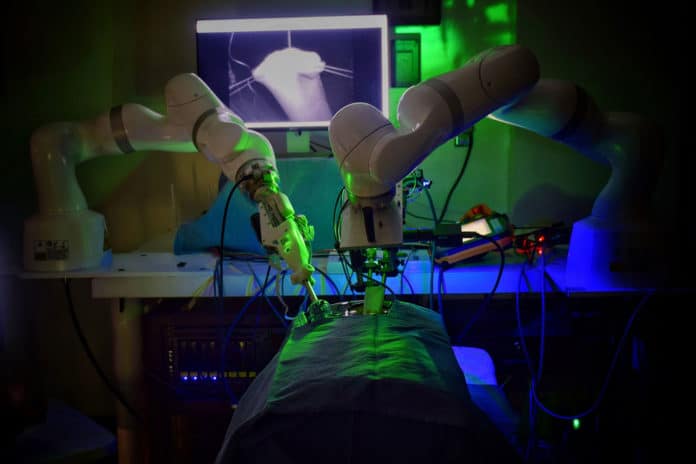Autonomous robotic surgery has the potential to provide efficacy, safety, and consistency independent of an individual surgeon’s skill and experience. Now, a team of Johns Hopkins University researchers says a robot has performed laparoscopic surgery on the soft tissue of a pig without the guiding hand of a human – a significant step in robotics towards fully automated surgery on humans.
The Smart Tissue Autonomous Robot (STAR) performed laparoscopic surgery on four pigs, tasking it with reconnecting two ends of a severed intestine. According to the researchers, the robot excelled at the intestinal anastomosis, a procedure that requires a high level of repetitive motion and precision.
“Our findings show that we can automate one of the most intricate and delicate tasks in surgery: the reconnection of two ends of an intestine. The STAR performed the procedure in four animals, and it produced significantly better results than humans performing the same procedure,” said Axel Krieger, senior author of the paper.
Connecting two ends of an intestine is arguably the most challenging step in gastrointestinal surgery, requiring a surgeon to suture with high accuracy and consistency. Even the slightest hand tremor or misplaced stitch can result in a leak that could have catastrophic complications for the patient.
Axel Krieger, an assistant professor of mechanical engineering at Johns Hopkins, helped create the robot, a vision-guided system designed specifically to suture soft tissue. It advances a 2016 model that repaired a pig’s intestines but required a large incision to access the intestine and more guidance from humans.
STAR robot’s new features allow for enhanced autonomy and improved surgical precision, including specialized suturing tools and state-of-the-art imaging systems that provide more accurate visualizations of the surgical field.
Soft-tissue surgery is especially hard for robots because of its unpredictability, forcing them to be able to adapt quickly to handle unexpected obstacles. The STAR has a novel control system that can adjust the surgical plan in real-time, just as a human surgeon would.
“What makes the STAR special is that it is the first robotic system to plan, adapt, and execute a surgical plan in soft tissue with minimal human intervention,” Krieger said.
“Robotic anastomosis is one way to ensure that surgical tasks that require high precision and repeatability can be performed with more accuracy and precision in every patient independent of surgeon skill,” Krieger said. “We hypothesize that this will result in a democratized surgical approach to patient care with more predictable and consistent patient outcomes.”
